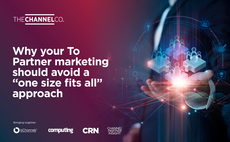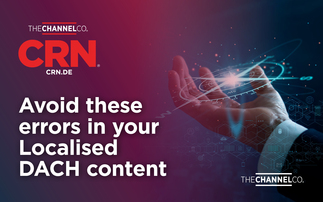
The Channel Company Vendor Services
The Channel Company, which incudes CRN, Computing, Channel Partner Insight and bChannels, has come together to create an end-to-end vendor service to provide more transparent and reliable returns from the IT Channel.
This is the sixth in a series of blogs explaining some of the biggest challenges facing channel leaders in 2023, collated from our bespoke research and editorial coverage. Read on and get in touch to learn about how the distributor market is adapting to the changing technology landscape, and how you can adapt your thinking about distributors accordingly.
For enterprise technology companies, distributors have been an essential component of the go-to-market strategy. However, many of these companies have been asking a question with increasing seriousness - are distributors necessary and relevant any more?
After all, the distributors that are there have been furiously consolidating over the past five years (Tech Data and Synnex, Westcon-Comstor and Synnex), so even if you wanted choice, you are not necessarily spoilt for it. Furthermore, the advent and maturing of public cloud marketplaces has dangled the tantalising question, especially for services and software providers - will disintermediation consume distribution? Let's not give up on distributors yet.
The pandemic has clearly demonstrated the important reality of supply chains and having entities beyond OEMs who have extensive logistical reach is a very real value-add.
In fact, - far from moving away from distribution, the very public cloud providers are actively investing to increase their distribution networks.
While public cloud created a new type of distributor that supports the cloud solution provider partner with billing, provisioning and support capabilities and recruited completely new and unexpected entities to this business model, inadvertently it also underlined a huge divide between entities that are very willing to provide software services and those that are happy to take on hardware distribution as well.
Distributors continue to prove their worth:
- Distributors bill and collect money from your downstream partners (imagine doing that yourself!).
- They extend them credit lines that your finance department would not, they provide them with payment terms which could be preferential to yours.
- To an extent they manage downstream partners.
- To an extent they engage in demand generation.
- They provide support across hundreds of product lines and advice on best of breed solutions, to partners who would not be able to parse this information with the resources they have.
- In a competitive marketplace, having a captive audience that has to listen to your message is an advantage.
- Most importantly, this is the business they are in - aggregating downstream partners and supporting their opportunities. It is not the glossiest business in the world, it does not have the gravitas of a Fortune 100 customer press release on strategic multi-year collaboration, but somebody has to do it. Better still if that somebody, actually wants to do it, can do it and is good at it. Distributors want to, can and have made a living of it.
Even in 2022, when researching the growing influence of public cloud marketplaces, we saw some software vendors consciously forcing public cloud vendors to include distributors in the chain of channel led marketplace sales - because they wanted to preserve their channel and capability that distributors provide.
The takeout here is that despite facing some legitimate pressures, distributors have an inherent set of value that they bring to the equation but even more importantly, these same pressures caused some of them to evolve to the point where their OEM/ISV partners are taking active steps to defend and preserve them.
So what do these evolved distributors look like?
The advent of SaaS and public cloud was a calamity to the world of traditional distributors. At first broadliners found themselves edged out by direct sales, and value-added distributors saw the very source of their value add decimated as revenue from traditional infrastructure started flowing to public cloud.
Neither had the teams, the skills or the desire, on the sales floor to drastically change the situation - the inertia of historic business competed with new beginnings and new cloud business units to the detriment of those vendors who made the bet on sticking only with them.
That's why, between 2014 and 2018 we saw the emergence of a host of new entities on the distribution arena. Some came as additional business units of mainly US-based National Solution Providers (NSPs), some emerged as an additional business that big system integrators carried, some were hosters adjusting to new 'cloud realities' and some were completely new entities that were floating as start up projects that finally found their niche.
Admittedly, a lot of these were side businesses and entities catering to SMB, but they quickly filled the void that traditional distribution was struggling to address. By 2018, these started making acquisitions of their own and by 2020s some reached a billion dollars in turn over.
This coincided and precipitated two notable things. Traditional distribution was finally galvanized into action to build out capabilities, systems and teams to become a serious contender for 'cloud' business. Large hardware OEMs adjusted to new realities and launched their 'as-a-service' offerings in earnest to compete with cloud, seeing their distribution network as a vital ally and a way to scale. On top of proliferation of new partner business models around managed services and packaged software - all of the above added to a distinctly new distribution landscape.
We have:
- Cloud first distributors - supporting downstream channel in billing and provisioning public cloud offerings.
- Distributors catering to MSPs.
- Distributors that focus on networking security.
- Distributors that build IoT and / or AI/ML solutions using FPGA boards.
- Distributors that are able to orchestrate a multi-vendor as-a-service solution.
- Distributors that build marketplaces.
- Distributors that are able to do system integration in public cloud.
- Distributors that serve as a connector for ISVs to large public cloud environments.
- Distributors that serve as the best entry point into a specific geographical market.
However, not all distributors have made the leap to fit the new technology landscape, and it can be difficult to identify which are ready to prosper in the immediate future - without a good methodology to separate them.
If you'd like to assess how your current distributor network is performing, and how you could drive more growth through distributors, then get in touch today regarding our new distributor assessment tools.













